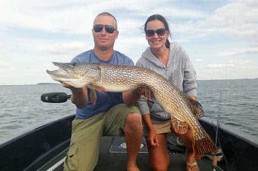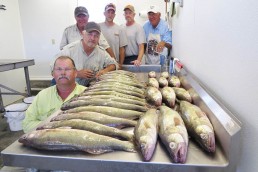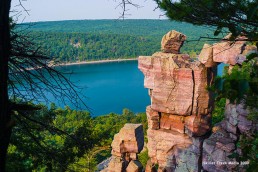Devils Lake Trophy Pike Pursuit a Family Affair
by Devils Lake Convention & Visitors Bureau
The quest for giant northern pike has drawn anglers to the far reaches of the globe. One of those secret spots has been discovered and those in the know expect to see a legit 50-inch pike there this season.
The family that discovered the mother lode of monster pike, Boyd LaFleur and sons Blake and Nathan fished in their backyard. Actually, they live near Devils Lake, which swallowed farms, homes, ponds and marshes as it grew from 40,000 acres in 1990 to four or five times that size today. Located in the middle of North Dakota, this lake produced more than 100 pike exceeding 40 inches for the LaFleur team in the past three years. That compares to 87 trophy pike that size or bigger caught and released in the state’s release program from all state waters from 2008 to 2012. Another 105 were registered in the state’s “kept” Whopper club during those five years.
“If you think it’s easy, it’s not,” Boyd said, “After wondering where these top predators hid out, we started fishing them exclusively about 10 years ago. We went everywhere; fished every lure imaginable; cast and cast; searched and searched; and for the first three years, caught zero pike over 40 inches.” In all previous 50 years of fishing Devils Lake, he only had one pike that size, and it was an accident. How did it begin?
Boyd grew up catching mostly pike across Manitoba with his grandpa. In the 1960s Devils Lake only contained pike. That changed when walleyes were stocked in the 1970s, and quickly became the most popular fish. “I fished lots of walleye tournaments, and always seemed to be running on weekends. When my oldest son was five, I couldn’t spend time with him, and decided right then to spend all my time teaching my sons.”
The LaFleurs fished like many anglers on Devils Lake for whatever bit, which meant walleyes, perch, white bass and northern pike. But, it dawned on him, and he said, “Most people felt every fish but walleyes were second-class citizens.” He observed that 99 percent of walleyes caught were kept while 99 percent of pike were released. People need education about cleaning pike, which will take them from the lake to the table. “It’s the only fish our family eats, and no matter how it’s prepared, it’s delicious,” he said.
Area fisheries biologist Todd Caspers said, “The Devils Lake pike population is doing very well, although people don’t harvest very many. According to our creel surveys, pike are mostly released and very under-utilized.” North Dakota’s fisheries management supervisor Scott Gangl echoed these sentiments, and said, “Over 80 percent of anglers in our surveys prefer walleyes.” That’s why the state raised the daily pike limit to five, from three. He said, “We want the people that want to harvest them to harvest more of them.”
The North Dakota Game and Fish Department has a “how-to” pike-cleaning and de-boning video on their website, as does Devils Lake tourism at devilslakend.com. The key advice for keeping Devils Lake a premier trophy pike fishery, according to the LaFleurs is to release every pike over 32 inches. “Just because it’s the biggest fish you ever caught doesn’t mean you have to keep it,” Boyd emphasized. “Get a fiberglass replica, and enjoy it for the rest of your life,” he said.
The breakthrough came when he asked his sons to pick up the gaudiest, most obnoxious large lures possible on a trip to Fargo. They returned and dumped out a three-blade spinnerbait weighing 2 ounces on his desk. He laughed, but took it to the lake. Fishing an 8-foot deep weedline on a big flat, he flung the hardware as far as he could. He recalled, “Three cranks of the reel handle, and a fish hit. It was a 44-inch pike. I caught three that day over 40 inches, and the game was on.”
The discovery led them to narrow down typical big pike spots to large expansive flats, usually quite a ways from shore with weed growth being the key. Deep water must be nearby. These are “rolling flats” in about 6 to 10 feet of water. He said, “They like large lures, and we fish 7-1/2- to 9-foot rods with at least 40-pound braided line and a 100-pound fluorocarbon leader. Top lures have been the size 15 Glide Rap (not being produced, but available on the Internet); the 7- to 8-inch Shallow Raider; and the Lil Hustler 2- to 2-1/2-ounce spinnerbaits with gold blades and cream/brown skirts.
The largest pike the family landed and photographed (and released of course) was a 48-inch trophy. “I know a ‘50’ is swimming in Devils Lake,” Boyd said, “And I’m amazed how many trophy walleyes we catch on these large lures.”
From the eyes of son Nathan:
Son Nathan said there are areas all over the lake that match his dad’s tips on where to fish. “When ice goes out, we’ll be there, and it’s all about food then,” he said. With minimal run-off this spring, he plans to target the small shallow bays where pike spawn and that hold food. They will be his first target. Over the recent high-water years, pike have moved to the many lakes north of town including Dry, Mike’s, Irvine, Silver and Pelican. “They find their way into these lakes and stay because of the food,” Nathan said.
In springtime, he targets fish no matter the water temperatures, and catches them when it still registers in the mid-40s. “Late-day is best, which gives the sun time to do its thing. They may not be actively chasing, but they will hit something if presented slow enough.” He prefers stalking and sight-fishing, under perfect conditions (no wind) with a fly rod. He uses a casting rod mostly, tossing a size 10 X-Rap in spring. “Smaller is not necessarily true when it comes to big northerns. I use muskie tackle,” he said.
His box contains Shallow Raiders, size 12 X-Raps, big jointed Shad-Raps, Bionic Bucktails and other giant spinnerbaits, Suicks and other glide baits from about mid-May through the summer.
He throws these heavy lures where the wind dictates. He said, “These are 3- to 9-foot flats adjacent to deep water with weeds present. If the wind has been blowing in, check both sides of the weeds for the warmest water. Wind pushes the bait and warm surface water. If food is present, so are the big pike.” He watches the sky, and where white pelicans are diving or swimming in flocks, he knows white bass are present. That’s where he seeks the biggest pike.
His casting tackle is usually a 9-foot rod, 50- to 80-pound braid, heavy fluorocarbon leaders (says his dad borrows his), and Shimano Calcutta 300D or Abu Revo Toro 50 reels. Nathan urged all anglers to follow these tips:
1. Release all trophies.
2. Keep pike from 5 to 7 pounds.
3. Think replicas for the wall (all that’s needed are a couple good color pictures).
4. “Devils Lake is just showing what it’s capable of, and the next few years will be really exciting.”
The LaFleurs “just fish” and do not guide. They are not after publicity. If people see them fishing, and visit with them and want to fish that area, they move to another likely spot, and Boyd said, “There are thousands of good spots to fish here.”
For more information…
The Devils Lake Chamber of Commerce tournament, June 26 to 27, is designed for walleyes, but offers big pike daily prizes. For more information about Devils Lake events, lodging, fishing conditions, guides (dozens of excellent guides know the lake well), a map of launch ramps, and much more, go to devilslakend.com or 701-662-4903.
MWO
SHARE THIS POST
Did you enjoy this post?
You can be among the first to get the latest info on where to go, what to use and how to use it!
MWO
We believe being outdoors is good. With more than 1,000 articles each year, MidWest Outdoors magazine is all about sharing outdoor experiences with you—where to go, what to use and how to use it… whether you’re close to home or on that trip of a lifetime.



